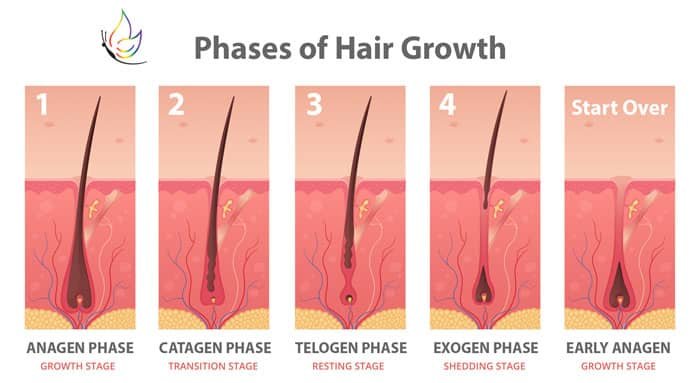How does hair grow?
Hair grows in 4 different phases: anagen, catagen, telogen, and exogen.
ANAGEN (Growing) Phase
- The anagen stage is the growing period of a hair follicle.
- It lasts anywhere from two to seven years
- 90% of the hair on your head is in this phase
- In this phase, your hair grows around 1/2″ a month.
- As we age the anagen phase decreases.
CATAGEN (Transition) Phase
- The catagen stage is the transition period of hair growth.
- Hair follicles prepare themselves for the resting phase.
- It lasts around 1-3 weeks.
- During this phase, the hair “detaches” from your skin, but it usually doesn’t fall out until later, when the new hair “pushes” it out from your scalp.
TELOGEN (Resting) Phase
- The telogen stage is the resting period of the hair cycle. And the cycle where the hair prepares to fall.
- It usually lasts 2 to 4 months.
- When a person is stressed, lacking proper nutrients, or suffering from other health conditions more hair follicles than normal enter the telogen phase.
EXOGEN (Shedding) Phase
- The exogen stage is the shedding period of the hair cycle.
- It usually lasts 2 to 4 months.
- It’s normal to shed about 50 to 150 hairs on a daily basis.
- After the exogen phase, the follicle then returns to the anagen phase and the cycle repeats.
What can disrupt the hair cycle?
Several factors can affect the hair cycle. Some of these factors are internal imbalances such as stress, and nutritional or vitamin deficiency, but many other factors such as diet, illness, thyroid issues, oxidative damage, pollution, UV exposure, hair styling, and hormonal fluctuations and imbalance can disrupt the hair cycle. You might also be genetically predisposed to hair thinning, which can cause you to suffer a gradual hair volume reduction.
How do hormones affect the hair cycle?
Testosterone, a hormone present in both women and men can indirectly be harmful to the hair follicle. When Testosterone combines with a 5-alpha-reductase enzyme it converts into DHT (Dihydrotestosterone). DHT binds to the hair follicle and blocks the follicle from the bloodstream, depriving it of nutrients that shrinks the follicle causing many of the hairs to fall out. Under normal conditions, women have a minute fraction of the level of testosterone that men have, but even a lower level can cause DHT-triggered hair loss in women.
What can you do to minimize hair loss?
- Take a robust hair supplement with a DHT blocker
- Reevaluate your diet and make changes accordingly
- Manage your stress level
- Find out if your issue is related to an illness and take steps to get well
- Massage your scalp to boost blood flow
- Be gentle to your hair. Rethink how you style your hair and use natural products and less harsh treatments
What do we recommend to minimize hair loss?
At Rejuvent we offer PRP for Hair Loss and 2 supplements to help with hair loss.
Treatment for hair loss
The Platelet-Rich Plasma for Hair Loss treatment harvests your blood’s PRP and uses your own growth factors to repair the hair follicles and trigger them to go into the active phase. This treatment is very effective in increasing the number of hairs and making the existing hair healthier. Read more about the PRP for Hair Loss Treatment.
Supplements for hair loss
Nutrafol Advanced Thinning Hair & Hair Loss Supplements
- Multi targets the leading causes of hair loss including stress, DHT, inflammation, aging, and environmental toxins.
- Improves hair health while also improving overall well-being. Contains multiple vitamins, antioxidants, and ingredients to block DHT.
- 4 pills 1X a day. Pills can be dissolved in a liquid or added to a smoothie.
- Save on Nutrafol products
Nutrafol Hair Supplements are available for Women, Women Vegan, Women’s Balance, and Men.
Viviscal Professional Hair Supplements
- Helps to nourish thinning hair from within and promotes existing hair growth.
- Contains AminoMar (Marine complex with Shark Cartilage), Biotin, Apple Extract, and Vitamin C – key nutrients essential for healthy hair growth.
- Take one pill 2x a day.


